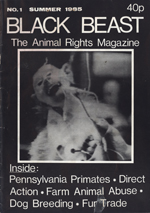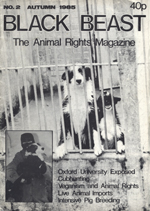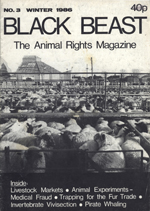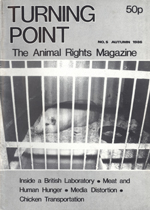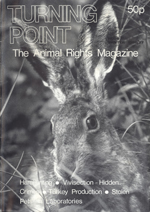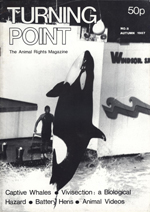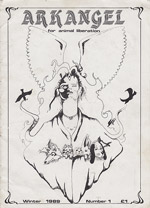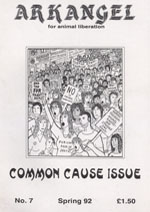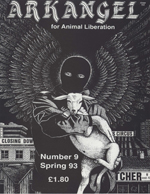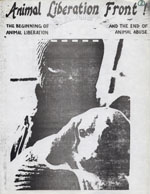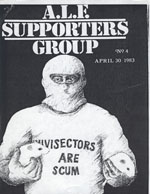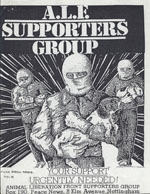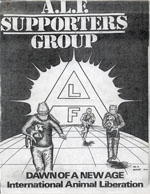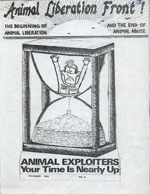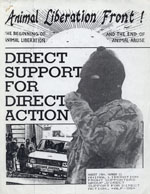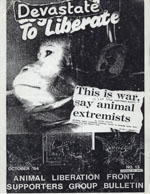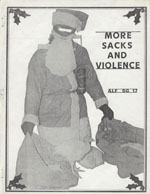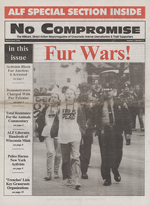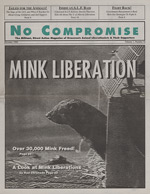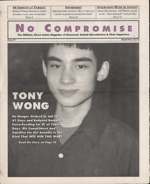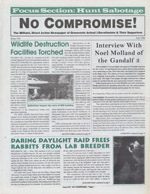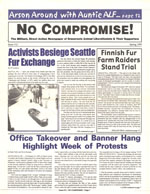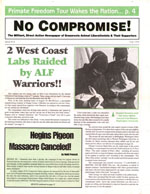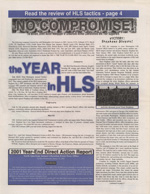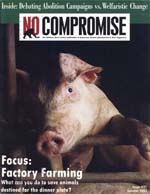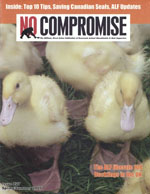We are still seeking additional issues Turning Point. If you have them- or other publications of note- please contact us!
Hunt Retribution Squad
Arkangel
Arkangel 1-5, 7-11 (1989-1994. London, England)
Vivien Smith, whom I had previously worked with in publishing the ALF Supporters Group newsletter, had recently been released from prison and we teamed up again to produce the first issue of Arkangel, with me doing most of the writing and Viv typing it out and putting it together with artwork to create the magazine.
The second issue was produced in a similar fashion but, after that, everything had to change, as the prison stopped me from sending out articles, following complaints from the vivisection industry, and Viv was put in prison again for ALF actions.
The omission of issue #6 is not an error- it was never printed. Arkangel’s offices were raided just before publication of the issue. We are still seeking additional issues of Arkangel. If you have them- or other publications of note- please contact us!
The Complete ALF Supporters Group newsletter
The ALF Supporters Group newsletter 1-19 (1982-1986. Nottingham / London, England)
The organization’s newsletter, affectionately called, “The SG,” contains historical details of the early days of the ALF you won’t find anywhere else. Between sometimes amazing, sometimes amateurish covers, the writing quality varies broadly. At its best it is charming and at its worst it is cultish. Any which way, it was trailblazing- and nowadays, rare! This collection was a tough one to obtain.
The SG has gone through several incarnations since British Law enforcement shut this one down in 1986. (While carrying out the investigation for the notorious Sheffield trial that sent Ronnie Lee to prison for 10 years, the police raided the SG and charged its editors with incitement. Everything published by the SG afterwards had to be run past a lawyer first, but this didn’t stop further raids, arrests, and convictions of those involved in the newsletter.) It is still being published today, copies can be ordered from www.alfsg.org.uk.
The Complete No Compromise
No Compromise 1-30. Includes Strategic Non-Violence for Animal Liberation insert included with issue #8 as separate publication. (1996-2006, Sacramento, CA / Minneapolis, MN / Caldwell, NJ / Old Bridge, NJ / Santa Cruz, CA / San Francisco, CA)
Text postNo Compromise, which billed itself as “The militant, direct action newsmagazine of grassroots animal liberationists and their supporters,” was the most important animal rights publication of the 1990s. Despite its many problems, frequent delays, and constant changes in editorial staff, the magazine energized the movement in a way that is difficult to explain to a generation that never witnessed pre-internet activism.
In the mid 90s there were a few, isolated groups around the country who were participating in civil disobedience actions and staging loud protests against local labs and fur stores. These groups were largely unaware of each others’ existence and without a gathering like Earth First!’s Round River Rendezvous, unable to share tactical advice or co-ordinate targets.
In 1996 there was a national meeting of animal rights activists in Washington DC dubbed World Animal Awareness Week and March for the Animals. The event was considered a failure as only 3,000 of the estimated 100,000 participants materialized. But staff from No Compromise were present passing out the first issue and asking grassroots organizations for their contact information. Suddenly groups like the Animal Rights Direct Actions Coalition were meeting with the Coalition to Abolish the Fur Trade, the Animal Defense Leagues, and the Student Organization for Animal Rights.
As the grassroots grew increasingly aware of the efforts of other organizations, regional demonstrations began being planned. The first such demonstration after the March for Animals took place at the Seattle Fur Exchange, where activists used bike locks to attach themselves to each other and block the drive way of the fur auction. All of the action got reported on in No Compromise, and suddenly bike locks gave way to lock boxes, which gave way to super boxes and barrels and tripods as civil disobedience tactics spread across the country wherever the magazine was distributed. There was an explosion not just in voluntary arrest scenarios, but also in underground direct action. The print runs of No Compromise kept climbing and it became the must read publication for animal rights militants.
The tone of the magazine at its start was hopeful, and each issue was packed with increasingly daring protests and direct actions. As the movement struggled to find focus and dealt with the departure of founder Freeman Wicklund, the the mood shifts to frustration and confusion, only to be plucked back into hopeful territory with the rise of SHAC.
After 30 issues, the steering committee of No Compromise decided to stop publishing in 2006. Their decision could not have come at a worse time. With the SHAC website and newsletter killed by the convictions of the SHAC 7, Bite Back being published only sporadically and with a limited focus, and the Earth First! Journal mired in infighting, the sudden absence of No Compromise meant that the primary sources for radical animal liberation news, opinion, and strategy were the twin sewers of online social networks and the North American Animal Liberation Press Office. These were dark times for our movement, and we are only just beginning to recover.
Animal Warfare
Animal Warfare (1989, David Henshaw, London, England)
Based upon a television show of the same name, Animal Warfare was one of the first books written about the rise of animal liberation militancy. Its author, David Henshaw, is decidedly anti-animal rights, and at times his coverage is so unfair and deceitful that it’s tempting to write this publication off as mere tabloid journalism. That would be a mistake. While clearly written from the perspective of a person intent on smearing activists, this paperback also provides us with a look at our history less slanted by movement propagandizing and cheerleading. At times that picture is not pretty.
Authored during the rise of what some English activists called “the cult of militancy,” Animal Warfare takes the fodder provided by the most extreme actions of the early 80s and spins an ugly tale of car-bombs, poisoning hoaxes, graveyard desecration, and alliances with racist organizations such as the National Front. While there are plenty of grotesque distortions of facts, there are also valuable lessons to be learned about how the best tactical decisions consider our movement’s ability to survive backlash while building mass.
At a time when many modern activists seem intent on repeating the mistakes of the past, (or at least blogging as if they intend on repeating those mistakes), Animal Warfare contributes to our ability to learn about media falsification, the dangers of militaristic posturing, and the events which led to the weakening of England’s mass militant movement for animal liberation.

